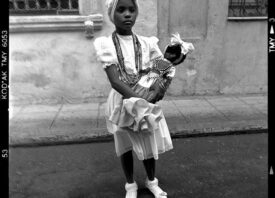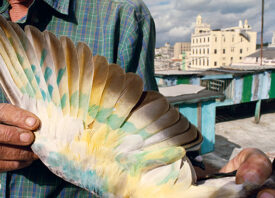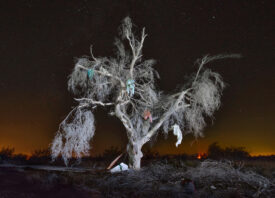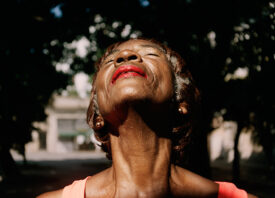Search this site
Cuba’s Underground: Diversity, Art, and Rebellion

Shibari, tattoos, and drag queens are not the first things to come to mind when one thinks of Cuba. However, photographer Jean-François Bouchard shows us that there is an underground in Cuba that is diverse, creative, and highly aesthetic. Bouchard has been photographing hidden Cuba since 2016 and is releasing his book The New Cubans on November 7, 2024, at Paris Photo.
How did you first encounter this “lesser-known Cuba” shaped by nonconformity, creativity, and diversity?
“In 2016, a friend introduced me to a young actor who was very involved with the LGBTQI+ community. And he said, “Come see another side of Cuba that you might not have seen.” He then took me to a drag queen bar which was everything you would expect from such a venue…Except that it was owned by the government (like pretty much else in Cuba). This fascinated me because I had read about the shocking concentration camps in which the very same government was incarcerating gay men in the ‘60s. How do you go from operating gay prisons to owning a drag queen bar?”

How long have you been working on this series?
“The first images were shot in 2016 but I only kept one for the book.
“I only really started in 2021 when I connected with Devon Ruiz on Instagram. She is a young, dynamic, creative woman with iconoclastic looks—she has more than twenty tattoos on her shaved head—and an attitude to match. She was dabbling in photography, painting, dance, modeling, and fashion while seemingly being the queen of Havana nights. We hit it off immediately and she became my key to a Cuba that not many foreigners get to see: a spectrum of young people from various alternative lifestyles to the blossoming LGBTQI+ community. She was my entry point into a Cuban parallel world that foreigners know little about, much less get invited into.”
How did you gain access to the intimate and often private spaces of these young Cubans?
“Devon was my key to the city. Very rapidly it expanded to her group of friends who all became involved in one way or another.
“One night, I followed her to visit her friend Osmel Azcuy who was filming a music video in a very traditional house with its maximalist, frozen-in-time Cuban decor. The house was filled with young, tattoo-covered people who looked like they had been plucked out of Los Angeles, Berlin, or Tokyo. The contrast was striking between “traditional Cuba” and “new, young Cuba.” The clash was so powerful that it created a surreal, almost cinematic experience for me. I wanted to capture that feeling and made my first images there. For the first time in over twenty-five years, I felt that I got something new in the photographs.”

Many of your subjects have left or plan to leave Cuba. Why is this, and how do you see this culture evolving?
“Just as I started the project, the situation deteriorated in Cuba and migration shot through the roof. This was mainly due to the tattered economy providing limited prospects within the country. But in my opinion, this is just part of the story. What compounds the dissatisfaction and the urge to leave is the simultaneous exposure to what is happening elsewhere in the world via the Internet and social media. The contrast is shocking to many Cubans.
“Consequently, migration is now at an all-time high, surpassing the great migration crises of the ‘80s and ‘90s combined. It is estimated that 2% of Cubans leave the country each year. That’s 200,000 people! Some leave by plane with proper visas but others embark on dangerous journeys that claim lives.
“Early on in this project, it became obvious that a large portion of my subjects would be leaving the country before I could complete it. I became aware that many of my images would act as mementos of dissolving groups of friends and of lives left behind. It made my work more emotional than what I am used to.”

How did the recent widespread access to the Internet in Cuba impact the youth culture you documented?
“During my visits prior to starting this project, I was witnessing the early impacts of Internet access and the influx of Americans to the island (which only lasted a few years under Obama). But Internet access was still a very cumbersome affair consisting of sluggish, public Wi-Fi access points in parks where groups of people would assemble with computers and phones. It was bizarre.
“Many also subscribed to the “El Paquete,” a black-market distribution of memory sticks with bootleg copies of the week’s most popular YouTube videos, Hollywood movies, and Netflix shows. One gig of global culture for two dollars a week!
“But in 2019, it really exploded when Cubans gained access to the internet on mobile phones. Suddenly, the world entered the lives of young Cubans.”
What was the most surprising or unexpected aspect of Cuba’s youth culture that you encountered during this project?
“I was really surprised to sometimes feel like I could be with young folks from Tokyo, Los Angeles or Berlin. In a matter of just a few years, their influences became global. But at the same time, they have a rich and unique Cuban culture that still instills a local flavor to their world.”

In what ways has the Cuban art community responded to your work?
“Enthusiastically. Many of my subjects became collaborators and brought their friends to participate in the project. A Havana-based gallery will exhibit these works in the spring of 2025.”
How do you think the subjects you’ve photographed see their role in reshaping the perception of Cuba on a global scale?
“They are tired of many perceptions or clichés about Cuba. They want to be perceived as people who are also part of global culture and contribute to it.”
What do you hope audiences will take away from The New Cubans?
“My work is always about celebrating differences and stearing clear of biases. I hope people will discover a Cuba that tourists are not exposed to. I hope viewers will get that amidst the countless hardships of life in Cuba and despite the present-day migration crisis, the younger generation is shaping a new reality defined by nonconformity, gender diversity, and resilient creative expression.”

You can preorder The New Cubans here.



